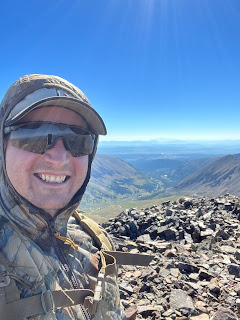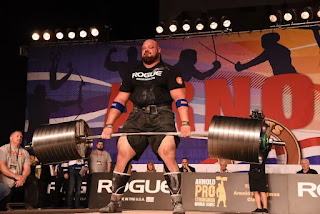Working out without rest days changed how I view training. At one point, my physical fitness was about being better at my job. At another point, it was simply about being better at lifting. Now, after 14 years of serious training, my training has become a way of life – instead of being a means to an end, it is the end.
Because of this change in perspective I have grown to value
my minimums more than my maxes. Before, my one rep maxes were the most valuable
things in my training. It is easy to look at training that way. It is the
mentality of the mountaineer. Summit the peak, then off to climb the next. Popular
weight training culture is the same. Hit a one rep max. Next week, add more
weight and hit a new max.
This simplified way of observing progress is helpful
and motivating, especially for the novice. I am not diminishing its value.
However, as my years of training have increased, so too has my vision – the
horizon is not the end. There is something beyond. With the experience of daily
training I have learned how to see beyond.
No longer are my peaks the purpose for training.
What can you do today?
This is the purpose of my training: today.
Most days, I’m bushwhacking in the valley. Not
summiting a peak.
 |
| Me and a Sorinex pack frame with 45 pounds of added weight at about 12,000 feet enjoying the views of peaks high above in the distance. |
Any seasoned lifter knows their maxes. When asked,
“what’s your max?” The lifter will respond with do you mean today, or my
best ever? This gets to the heart of training for today.
What can you do today? (Not what a calculator estimates
– what do you know?)
Today’s ability depends more on our baseline, our valleys,
rather than our peaks. My best bench press ever is 380 but I can only lift 315
today. But when I benched 380 could I have also hiked like I can today?
Absolutely not. Because of the specialization it took for me to lift that
all-time PR of 380 on the bench press I was unable to train for day-long hikes
up steep terrain above 13,000 feet. Today however, I can lift about 82.5% of my
best bench while also being able to do a whole lot more.
My general physical preparedness (GPP) has improved. My
baseline is now at a higher elevation than when I was in peaking in
powerlifting. No lifter can be at their peak strength day-in day-out, and
expect that height to rise beneath them, so why view your training with that
mindset and base your training upon that false notion? To do so is
self-limiting and shortsighted.
Today’s baseline is different than my baseline when I
was solely focused on powerlifting. Nevertheless, if I can raise my baseline
now, I am that much closer to being as strong as I’ve ever been. Or stronger. Despite
not training specifically for powerlifting. Increasing the elevation of my valleys
results in potentially higher peaks. That’s the essence of improving your
baseline.
I am not saying that specialization is bad. Instead,
think of it as being the route to summit that next higher peak. Specialization
requires technical skills, things focused on when preparing for a powerlifting
meet in the near future. In the valleys, where the approach is being made, our
baseline is most important; here technical skills are not the focus, work
capacity is. The higher elevation of the valley the higher the elevation of the
peak towering above. As I’ve said before, if a one rep max is the top of a
pyramid, everything below that apex are the variety of movements and all the
reps completed; work capacity is the foundation of your pyramid.
That’s the original analogy I used to describe my
training method about 12 years ago. It hasn’t changed much. Rather than an
object to be built, the analogy has changed to being akin to a lifetime
adventure. (Clearly influenced by these last six years of living in the shadows
of 14,000-foot peaks.) Failure to reach your peak strength is more often caused
by not being able to train enough, rather than some technical fault in your
lift.
Most of your training should be in the thicket.
Hacking away wildly as you blaze the trail to your next peak. Be content
working in its shadow, for a rush to the summit cheats yourself out of the work
needed to make the ascent.
In terms of traditional descriptions, the valleys are
off-season training, and the peaks are in-season. Or, for the powerlifter, high
variety high volume in the offseason versus peaking with high specificity; both
in movements and intensity. Moving between these is, in a word, periodization. I
find the visualization of hiking through a mountain range more appealing and
descriptive of the process. Adventure is inherent to the process. If your
training lacks adventure, force yourself off the beaten path, and work hard
creating a new one. In doing so you will develop work capacity.
Adventuring is fun. Training can be to. Adventuring
can be challenging. Training should be also. Never let a program bore you death
in the process of being ground into dust. Accepting that fate is how the adventure
ends. You will never summit another peak when you resign yourself to dying on the
slope of the final ascent.
By adding more exercise to your life you will be
increasing your work capacity; increasing the elevation of your valleys; thereby
increasing the elevation of those peaks towering in the distance. Do more now –
today – because you can, so you should.
Am I encouraging you to not have a training plan when
I say, “blaze your trail wildly”? No. Am I saying you need to push to failure
every day? Absolutely not. What I am encouraging you to do is ask yourself if
you could do more. If you can, then do. It is very difficult to make your way
without a map and compass, especially in the dense undergrowth of your valleys.
It is impossible to make your way if you do not have the fitness to sustain
effort. The triumvirate of progress are these: Consistency, Patience,
and Effort. Those three govern results.
 |
| On the steep craggy ascent up the north face of Pennsylvania mountain. |
Establishing a baseline
To clear things up: baseline training doesn’t have to
be in a separate phase of your annual training schedule. If you are peaking for
a meet, do a little less. That is all. What baseline training should be, is
what you can do often, so that you develop work capacity gradually.
Daily workouts do not have to be grueling and soul
crushing. Not every set needs to be performed to failure, or a max effort.
Sustained effort is key here. Consistency breeds results through accumulated
effort, not a single vein popping set. This is where having a baseline is
helpful.
What can you do today? Are you sure? Did you do it, or
are you just estimating?
A baseline workout could consist of a variety of exercises
in a short workout or a single set with one lift. This is up to you (and there
are more options and ideas than I lay out here; so be adventurous). In any form,
what a baseline is, is a means to determine actual performance – not merely an
estimation. A baseline workout can itself be progressed, either by adding
weight, or reps, or decreasing time, or modifying the movements. With any of
those progressions your baseline improves.
Here are two example baselines:
1. Deadlifting up to a certain weight for a single. Keeping the set easy and trying to make it easier each day. This should not be a max. What it should be is a weight that begins to challenge your technique. Doing a single set at this effort, of perhaps just one rep per day, is not going to do anything to your central nervous system (so calm down you geek-necked skeletons). Perhaps after several sessions this goes from a single, to a double, to a triple, and eventually, a set of five reps. In that process, your baseline has improved.
2. A
circuit of several exercises kept light and performed quickly, with the goal of
completing the circuit faster. Once a certain time has been reached, then add
weight or add reps to the circuit. You could increase those on one, two, or all
the exercises in the circuit. That depends on what your goals and abilities are
(both performance and recovery ability).
There are other options out there, but I’ll leave those
for you to explore and discover. Such is the adventure of training, where fun
in the gym is found.
 |
| 225x51 Squat. Fun. |
Example 1: A daily set
The first, a daily
deadlift set, is one that I am borrowing from someone else (Who? I cannot
remember). At a gym there was a bar loaded with 500 pounds. The goal was to be
able to easily hit that weight without a warmup each day. It didn’t start off
with 500 pounds always on the bar, but after many months that became many of
the gym goer’s baseline. Simple enough. You could do the same.
“What’s your deadlift?” Well
today I hit 500 without a warmup, in street clothes, because I knew I could.
This
kind of baseline training has the benefit of being focused on skill
development. Pavel Tsatsouline calls this “greasing the groove” (though he
applied it to bodyweight training, all lifts can benefit from this approach). The
deadlift can be replaced with press, or squat, or bench, or any other lift you
want to see improvement with. Frequency tends to improve performance, so long
as recovery is accounted for. A single set performed to the edge of technical
failure incurs little recovery debt. A baseline set in this manner may not necessarily
be considered a “full workout” but could easily serve as the buy-in or cash-out
of a workout as part of a larger program. Perhaps it is just one rep, maybe it
is a set of five reps. Where it starts and ends is up to you.
Before I start my workout, I must deadlift
my baseline.
If you are not training
daily, maybe your current rest days change into lifting days simply by doing
one set with one movement. Once you’re comfortable there, try pairing that
baseline set with a second movement. Over time this may develop into a workout
like the second example (not that it must, but the option is there).
The single deadlift set
of one rep, or a multi-rep set, is just an example. If you wanted to get better
squatting, then squat. Same for pressing or bench; or any other lift you want
to get better at. That is partly why such an approach to baseline training is
so fantastic: it gives you an opportunity to practice a lift without forcing a quantitative
progression (like adding weight or reps each workout). Instead the focus could
be qualitative (improving the look and feel of the lift).
Maybe your deadlift doesn’t
need a half-dozen accessory exercises afterwards to improve. Perhaps you just
need to deadlift a little more. Doing one set a day at the limit of your technique
could bring better results with less fatigue and in less time. Don’t believe
me? Try it and see.
“But Cody, I don’t want to go to the gym to just do a
single set on my worst lift.”
Try walking on the treadmill after.
You probably need the cardio.
Or try example two.
 |
| Or you could try this kind of endurance work. Not for the weak willed. |
This should be kept simple.
Choose between two and four exercises that you can easily pair together. I
would start with just two exercises and have a total rep goal. Keep the weights
light and the pace quick – but not soul crushing. Time your work. Try
decreasing that time when you repeat this workout while keeping the same two
exercises with the same weight and reps. You could do this on your current rest
days to ease into training daily. The goal is to introduce work that is easily
recoverable while also serving to improve other aspects of your physicality.
Maybe that is simply improving your stamina while also making you better at a
lift you want to improve.
Carrying forward the
previous example with deadlift, a couplet to improve that lift would be
something like deadlifts and pull-ups, or sit-ups (or another upper back or ab
exercise). If you are already decently fit and your recovery habits are solid,
then start with a triplet (three exercises together). One I like doing is all
three: Deadlift, pull-ups, sit-ups. Maybe after several weeks you turn this
into four exercises together by adding the press.
You could start with a deadlift
single at a weight that challenges your technique, followed by a set of half
your max reps of pull ups (perhaps you can do 20 reps; this set should be just
10 reps), followed by a half-set of sit-ups (half of your sit-up max reps;
maybe that’s 25 reps.) The half-sets follow General Gainz perimeters and as a
result create little fatigue because the number of sets isn’t too high while
also being enough to generate training adaptation. Start with just two or three
sets and scale up each time the workout is repeated. Remember, this work isn’t
to bury yourself in recovery debt. As such, it should be easily recoverable. Baseline
training in this manner will make your regular workouts easier and allow you the
opportunity to make them harder in a more sustainable way.
Another kind of daily
workout is one that I’ve done often. It is a triplet of pull-ups, sit-ups, and
kettlebell swings. For this I would set a limit of 10 to 20 minutes (depending
on how much time I had) and complete as many rounds as I could doing sets of 5
to 10 reps each; fewer reps per set allows for a faster pace between exercises,
therefore quicker split times; a quantitative value worth tracking.
Alternatively, instead of
fixed time (10 to 20 minutes) I would do a certain number of sets as fast as I
could. For me, a good breakdown that allowed for decent speed between exercises
was 3 pull-ups with 10 sit-ups and 10 swings for 10 rounds (fixed work). This allowed
for a fast pace and just enough recovery between exercises that I was challenging
my stamina (but not getting sloppy with my technique, or nauseas – and create a
different kind of slop).
At my gym all my clients
do the same warm up for this reason. It develops their baseline. They do three
rounds of 20 reps with my banded leg press, then 20 TRX rows, followed by 30
seconds on the ab roller and 30 seconds with the glute ham raise on the roller.
As they improve, I add a band to the leg press, increase the angle on the TRX,
and make them reach further or go for longer, or start to do reps with the roller.
Over the course of many
workouts this basic warm up has developed their legs, back, and trunk to the point
that the most common weaknesses quickly become their strength. While adding
tension or time to a movement I also challenge them to move faster between
exercises and to complete the reps faster. As a result, not only are they
getting better with these exercises, but their stamina begins to improve because
the density of the warm-up (their baseline) increases. A stronger baseline
makes their daily lives that much easier.
 |
| Trying guarantees Popeye forearms. |
I
encourage you to devise a workout that you can commit to doing daily, or at
least on your current rest days. This shouldn’t be something that leaves you
feeling beat up and broken (I hope I made that clear in the previous examples).
If you are averse to this idea, try making your baseline something fun. Maybe pistol
squats or bottoms up kettlebell presses because they’re unusual lifts that make
you feel like a circus performer. Ultimately, commit to something you can do
frequently and recover from easily, while also having a clear-cut progression
(adding reps, or weight, or decreasing rest times are the easiest to track;
alternatively, aim for a qualitative progression – look and feel). Once you
have the exercise(s) and progression figured out, do it.
Record your results. Then do it again, and again, and
again…
Do that workout until you stop improving.
By doing so, you will increase
your baseline and in the future be capable enough to reach higher peaks (when
you’re ready to summit them) because your work capacity (and perhaps also your
skill with a particular lift) has improved.
Remember, baseline
training is not about going hard as often as possible. It is about enjoying the
process – the adventure – that is physical development. Explore your abilities
as frequently as you can, and you will surely achieve a general level of strength
and stamina that characterizes the very fit (your future self).
What I’ve described in
this post is just the tip of the iceberg. It hardly scratches the surface of
this concept. Having worked out every day without a rest day for nearly four
years I have thought a lot about what baseline training is. I feel that if I
were to write out every little detail and idea it would be excruciatingly
complicated and far too longwinded of a post (like this one is already). Take
these concepts as inspiration and choose your own adventure.
Start training every day, today.
To see if you can.
 |

















